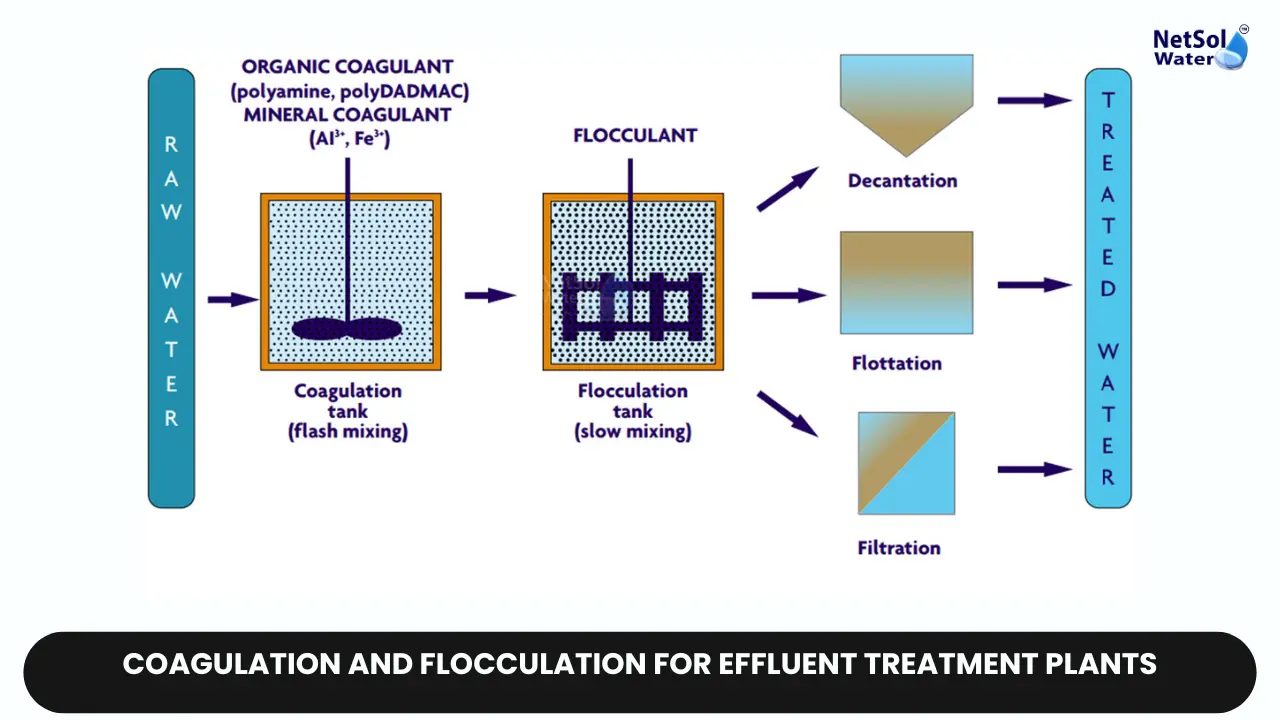Coagulation and Flocculation For Effluent Treatment Plants
Coagulation and flocculation represent critical processes within effluent treatment for removing suspended solids, nutrients, heavy metals, and other contaminants. By dosing treatment chemicals called coagulants and flocculants, colloidal and dissolved pollutants are destabilised and bound into larger agglomerates (flocs) that can then be physically separated for further processing or disposal.
Let's know about the science behind coagulation/flocculation, along with design and operational factors for achieving optimal performance at effluent treatment facilities.
Coagulation Mechanisms
During the coagulation step, multivalent cationic salts like aluminium sulfate, ferric chloride, or polymers are dosed into effluent streams to disrupt the stable, diffuse layer of negative charges surrounding colloidal and particulate contaminants. Destabilising these particles enables them to begin attracting and combining through physical transport mechanisms like Brownian motion, fluid shear and concentration gradients. Rapid mixing aids in the dispersal of coagulants.
Flocculation Kinetics
Following charge destabilisation during coagulation, flocculation promotes gentle particle collisions and agglomeration into dense, compact flocs that are more readily separated by settling or other solid removal processes downstream. Carefully calibrated hydraulic flocculation using velocity gradients within chambers or channels induces delicate particle interactions while minimising shear that could fragment newly formed flocs. Bridging with high molecular weight polymeric flocculants further enhances floc growth and strengthening.
Chemical Selection
Coagulant choice depends on factors like pH range, alkalinity levels, and the types of contaminants targeted for removal. Aluminium or ferric salts perform well over different pH windows, with sulfate or chloride versions suiting varying alkalinities. Pre-polymerized inorganic coagulants like polyaluminum chlorides provide greater charge density. Organic cationic polymers offer advantages for lower-charge surfaces or cold temperatures. Multiple coagulants are sometimes complementary. Flocculant polymers are similarly tailored to effluent characteristics.
Process Configuration
Most effluent plants configure sequential rapid mix, flocculation and solids separation stages. Providing sufficient flocculation volume enhances floc formation kinetics and minimises shearing. Baffled chambers or vertical/horizontal flow channels promote velocity gradients within specified ranges of 20-100 sec-1. Flocculation tanks may have multiple stagewise compartments for graduated mixing energies. A flocculator design combined with coagulant aids determines the overall capture of solids.
Residuals Handling
Coagulation/flocculation processes generate treatment residuals containing concentrated solids and chemical precipitates requiring disposal or processing. Mechanical degritting and clarification capture much of this sludge byproduct from tanks/chambers. Handling options include digestion, dewatering for landfilling, beneficial land application, or further treatment, such as dissolved air flotation for metal recovery. Speciality coagulants and recycling flocculant water can minimise residual volumes.
Treatment Optimization
Coagulant dosing represents a major operating expense, so optimising chemical usage is crucial for both cost and performance. Jar testing protocols quantify ideal coagulant types and doses for specific effluent compositions. Online monitoring of pH, turbidity, particle counts and zeta potentials facilitates real-time dosing adjustments. Process modelling using computational fluid dynamics validates flocculator designs.
Conclusion
Coagulation and flocculation processes serve to remove diverse contaminants from effluent streams at treatment plants. Proper chemical selection combined with strategic reactor design, optimised operating regimes, and residual handling enables facilities to reliably and cost-effectively achieve solids separation objectives. Continual innovation around greener chemistries, next-generation monitoring and process controls will further enhance coagulation/flocculation sustainability.
To explore customised commercial RO plants, Industrial RO plants, ETP or STP solutions for your needs in your areas and nearby regions, contact Netsol Water at:
Phone: +91-965-060-8473
Email: enquiry@netsolwater.com



